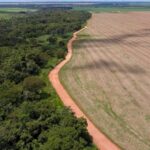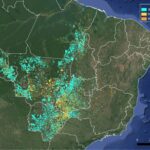Automotive industry exposure to deforestation

Cattle-raising is the leading driver of deforestation in the Brazilian Amazon, which lost 1.1 million hectares in 2020, the highest rate since 2012. In the past the pressure to stop deforestation concentrated on the beef supply chain and the three largest Brazilian meatpackers (JBS, Marfrig, and Minerva). Although leather is a co-product of beef, its links to deforestation have been largely ignored in discussions with government, the private sector, civil society organizations and consumer markets. Around 80% of the bovine leather produced in Brazil is exported and half of it is used in the automotive industry. This study draws attention to the exposure risk to deforestation of the leather supply chain, and specifically of businesses linked to the European automotive industry.

The study focuses on the operations of seven export tanneries which accounted for 80% of the Brazilian leather exports between 2018 and 2020: JBS Couros, Minerva Couros, Vancouros, Fuga Couros, Durlicouros, Matrotto Brasil and Viposa. It explores the deforestation risk exposure of slaughterhouses of the three largest meatpackers (JBS, Marfrig, and Minerva) and their links to the target tanneries operating in the Brazilian Legal Amazon. Using Brazilian export data, it examines the links between the target tanneries and European leather manufacturers, and then analyses the potential links between European tanneries importing Brazilian leather to car seat and interior component manufacturers and the European automotive industry.
The analysis of the potential links between the JBS, Marfrig, and Minerva slaughterhouses and JBS Couros tanneries is illustrated in Figure 2. The study considered deforestation (red areas in the figure) falling inside the slaughterhouses’ “buying zones” using the Imazon method. The tanneries linked to the slaughterhouses risk exposure to the same deforestation as the slaughterhouses. The study concluded that the tanneries operating in the Legal Amazon were exposed to a total of 1,345,118 hectares of deforestation in 2019 and 2020 in the Legal Amazon (including the entire Amazon biome and transition areas with Cerrado biome). JBS Couros alone was exposed to 1,153,299 hectares of deforestation in the Legal Amazon.

The second part of the study links the Brazilian leather exporters to the European market, the destination of 29% of Brazilian Wet Blue and 24% Brazilian semi-finished leather. The main European destination of Brazilian leather is Italy, which has 82% of European leather manufacturers. These in turn supply the five manufacturers that produce car interior components for around 90% of the European automotive industry (Adient, Lear Corporation, Faurecia and Toyota Boshoku). Their facilities are concentrated in the Czech Republic. The route taken by Brazilian leather used in the European automotive industry is therefore Brazil–Italy–Czech Republic and the countries where the largest automotive assembly facilities are located.
The report is a key technical document underpinning the engagement with five of the largest automotive companies operating in Europe: Volkswagen Group, BMW Group, Stellantis (a new joint venture of PSA Group and Fiat Chrysler), Daimler and Groupe Renault. The aim is to raise awareness within the automotive sector for improving transparency and traceability of the leather as an important co-product of cattle production in countries where this is the main driver of recent deforestation.
Key conclusions of the report
- Most of the Wet Blue leather exported from Brazil (80% of leather exports) comes from tanneries operating in the Brazilian Legal Amazon.
- The lack of traceability in the Brazilian cattle industry has a direct impact on the sustainability of the automotive leather supply chain.
- The lack of transparency throughout the leather supply chain conceals traces of deforestation and makes verification impossible for the many players involved.
- No company in the leather supply chain has adequate policies in place to avoid using leather linked to deforestation.
The full report can be downloaded here.
MEDIA REPERCUSSION
- Deutsche Welle (English)
- Deutsche Welle (Portuguese)
- RTL (German)
- Rio Times (English)
- De Olho nos Ruralistas (Portuguese)
For more information, please contact Joana Faggin (Senior Researcher)



